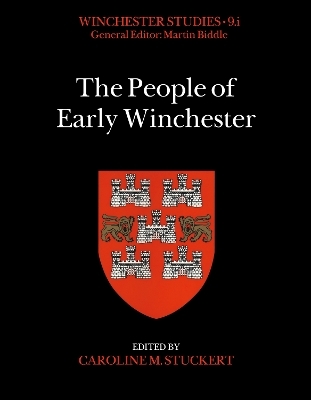
The People of Early Winchester
Archaeopress Archaeology (Verlag)
978-1-80327-014-2 (ISBN)
The People of Early Winchester traces the lives, health, and diseases of Winchester's inhabitants as seen in their skeletal remains from the mid-third century to the mid-sixteenth century, a period of over 1,300 years. Although the populations of other British urban areas, York and London in particular, have been studied over an extended period, this volume is unique in providing a continuous chronological window, rather than a series of isolated studies. It is particularly notable for the large sample of Anglo-Saxon burials dated to the 8th - 10th centuries, which provide a bridge between the earlier Romano-British material and the later medieval samples.
This study includes information on demography, physical characteristics, dental health, disease, and trauma collected from over 2,000 skeletons excavated from the Roman Cemetery at Lankhills and the Anglo-Saxon and medieval cemeteries of the Old and New Minster and Winchester Cathedral, as well as other Early Anglo-Saxon sites in neighbouring areas of Hampshire. The study establishes the underlying continuity of the population in spite of massive culture change between the Roman and Early Saxon periods, and delineates the increasing tendency to rounder skulls seen in the medieval period, a trend which is found in continental Europe at the same time. There were also significant differences through time in disease patterns and trauma. Leprosy, for example, is found only in post-Roman skeletons, while decapitations are seen only in Roman skeletons. Weapons injuries are confined to Anglo-Saxon and medieval individuals, although broken bones were common during the Roman period.
Caroline M. Stuckert (Connie) holds a B. A. in history from Bryn Mawr College, and an M. A. in physical anthropology and Ph. D. in archaeology and physical anthropology from the University of Pennsylvania. She has taught at Muhlenberg College and the University of Pennsylvania. Her research interests centre on the British Isles from the Iron Age through medieval periods, and she has conducted research and participated in excavations in both England and Ireland. In addition, she has enjoyed a 25-year career as a consultant and senior museum executive. A native Philadelphian, Connie has spent extended periods in Britain, and currently lives in the Philadelphia suburbs.
List of illustrations ;
List of tables ;
List of abbreviations ;
List of references ;
Part 1 Introduction – Martin Biddle and Birthe Kjølbye-Biddle ;
1:Introduction ;
2:Concept ;
3:The origin, growth, and completion of this study ;
4:The outcome: a summary ;
Part 2 Romano-British Populations from Lankhills and other cemeteries in Winchester – Caroline M. Stuckert ;
1:Introduction ;
2:Demography ;
3:Physical characteristics ;
4:Dentition ;
5:Pathology ;
6:Lankhills decapitations revisited – J. L. Macdonald ;
7:Catalogue of the burials from the Lankhills 1967-72 excavations ;
Part 3 The transition from Romano-British to early Anglo-Saxon in Hampshire – Caroline M. Stuckert ;
1:Introduction ;
2:Archaeological background: the Early Anglo-Saxon sites ;
3:Demography ;
4:Physical characteristics ;
5:Dentition ;
6:Discussion ;
Part 4 Anglo-Saxon and medieval populations from the old and new minster and cathedral cemeteries – Theya Molleson, Rosemary Powers, John Price, and Pauline Sheppard ;
1:Introduction ;
2:Demography ;
3:Physical variation ;
4:Discontinuous variation and congenital anomalies ;
5:Dental health ;
6:General health ;
7:Injuries ;
8:Conclusions ;
Part 5 The population of Winchester: A millennium of continuity and change – Caroline M. Stuckert ;
1:Introduction ;
2:Population continuity and change ;
3:Health and lifestyle ;
4:Discussion ;
Appendix A: Other burial groups found 1961-71 – Martin Biddle and Birthe Kjølbye-Biddle, with a contribution by Sue Browne ;
Appendix B: Statistical methods of determining sex developed for the study of the Hampshire Romano-British and Early Anglo-Saxon skeletal samples – Caroline M. Stuckert ;
Appendix C: Grave concordance: Anglo-Saxon and Medieval burials from the Old Minster and Cathedral cemeteries – Caroline M. Stuckert ;
Appendix D: Glossary
| Erscheinungsdatum | 18.05.2023 |
|---|---|
| Reihe/Serie | Winchester Studies |
| Zusatzinfo | Extensively illustrated with photographs, line drawings, maps, and charts |
| Verlagsort | Oxford |
| Sprache | englisch |
| Maße | 215 x 276 mm |
| Gewicht | 600 g |
| Themenwelt | Geisteswissenschaften ► Archäologie |
| Geschichte ► Allgemeine Geschichte ► Mittelalter | |
| ISBN-10 | 1-80327-014-4 / 1803270144 |
| ISBN-13 | 978-1-80327-014-2 / 9781803270142 |
| Zustand | Neuware |
| Haben Sie eine Frage zum Produkt? |
aus dem Bereich


